Brian Meert's Blog, page 94
February 1, 2019
How to Guide Moviegoers through the Sales Funnel on Facebook and Instagram
 February 1, 2019
February 1, 2019Anna Hubbel, writer at AdvertiseMint, Facebook ads company
  Krists Luhaers / Unsplash
 Krists Luhaers / Unsplash Going to the movies is a timeless pastime, but that doesn’t mean it’s easy to advertise your new film. Facebook recently conducted a study exploring the movie sales journey where cold audiences turn into warm audiences into customers. This article walks you through the three parts of the sales funnel that will have moviegoers flocking to theaters to see your newest release.
Top Funnel
At the beginning of the sales funnel, focus on informing your audience, as opposed to pushing for a hard sell. It’s the phase where you should inform your audience about the movie using several different trailers. Your ads at this point should send buyers to the trailer’s website where they can learn more about the film.
To inform your audience, run ads online and on social media. According to Facebook’s study, 58 percent of moviegoers discover new movies online. Also, 33 percent of all moviegoers buy their tickets online. So bring your trailer to where your audience spends a bulk of their time discovering new movies.
 Image Courtesy of Warner Bros. Entertainment
Image Courtesy of Warner Bros. EntertainmentWhen creating your trailers, design for mobile devices because the study also found that 51 percent of all moviegoers and 68 percent of young moviegoers discover new films when using the Facebook family of apps. Additionally, 57 percent of moviegoers ages 18 to 34 discover movies on their smartphone or tablet. To optimize trailers for mobile devices, format ads vertically and add captions for audiences who will watch them with the sound off.
It’s very important that you target the right audience at the top of the sales funnel. You can do this using Facebook’s LookaLike Audiences and Custom Audiences. Also, target the right people interested in your genre. The study found that 67 percent of all moviegoers rank genre as influential when deciding whether they personally want to see a film in theaters. Additionally, 70 percent are open to watching a different genre when with friends and family, so also target your audience’s social connections.
Middle Funnel
Once you’ve informed your audience about your movie, it’s time to run ads pushing for a sell. Use language that creates a sense of urgency, and run sale tickets weeks before opening night. According to Facebook, 68 percent of moviegoers decided to see the film before the day of the viewing. Additionally, 22 percent don’t decide until the same day of the movie, and nine percent don’t even decide what they want to see until they get to the theater.

Your ads should link to landing pages that show users where they can buy their tickets at a physical location and where they can buy tickets online. Marketing both options is important. Facebook’s study found that 76 percent of moviegoers ages 18 to 34 buy their tickets at the theater and 27 percent buy tickets through their mobile devices. Additionally, 79 percent of moviegoers 35 and older buy their tickets at the box office.
Bottom Funnel
The bottom of the sales funnel is the phase after the hard push to sell. This is where you remarket to customers while refreshing your ads so they don’t experience ad fatigue. It’s also where you remove converted customers from the audience list so that those who already bought tickets will no longer see your ad. You want to avoid annoying your customers after they’ve already converted. That’s the primary goal of the bottom funnel: pulling back a little but still remarketing to those who are on the edge of converting.
Start Building the Suspense
Now that you’re familiar with the different parts of the sales funnel, it’s time to build suspense for your movie with the right ad creative. Advertising your movie isn’t as easy as 1, 2, 3, but as long as you have a strategy in place and as long as you stick to it, you’re setting yourself up for a full house at the theater. Don’t keep yourself in suspense. Get to work!
Written by Anna Hubbel, writer at AdvertiseMint, Facebook advertising agency reviews
The post How to Guide Moviegoers through the Sales Funnel on Facebook and Instagram appeared first on AdvertiseMint.
January 31, 2019
More Ways to Interact on Instagram Stories Live
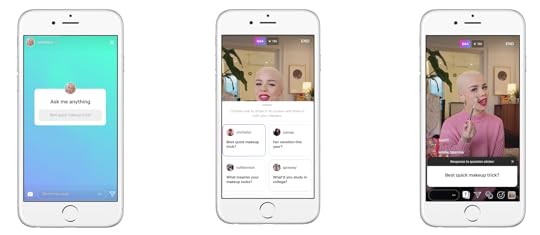 January 31, 2019
January 31, 2019Anne Felicitas, writer at AdvertiseMint, Facebook advertising agency
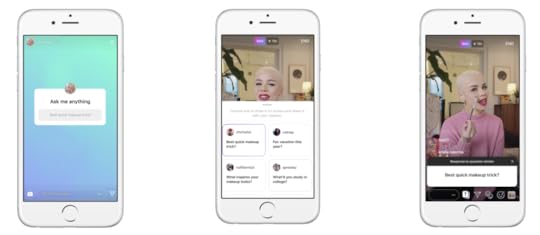  Photo courtesy of Instagram
 Photo courtesy of InstagramThere’s nothing more discouraging than watching your live viewers drop off, one by one. If only you could better captivate your audience, better keep their eyes glued to the screen.
Instagram has two features that make live Stories more captivating and interactive. The first, which you’re likely familiar with, is the Questions sticker that allows you to post an “Ask me anything” field to your story. To use it, open the Questions sticker on your Story then click the button that will let you go live. Receiving questions from fans isn’t the best part of this feature. You can also show viewers responses in real time.
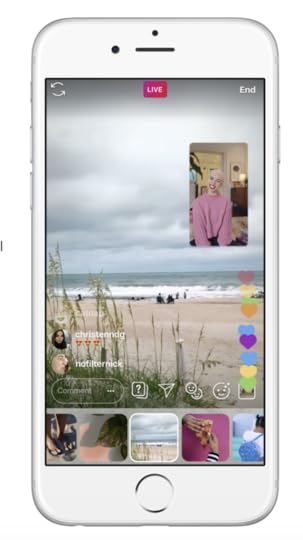  Photo courtesy of Instagram
 Photo courtesy of InstagramAnother fun Instagram Stories feature, only available to iOS devices (sorry, Android users), is photo and video sharing. The feature allows you to share images and videos from your camera roll to your viewers during the live broadcast.
If you need more ways to keep all eyes on you during your live video, try Instagram’s sticker and sharing features. They might just be the solution you’ve been waiting for.
By Anne Felicitas , editor at AdvertiseMint, Facebook advertising agency reviews
The post More Ways to Interact on Instagram Stories Live appeared first on AdvertiseMint.
With These Trends in Mind, Here Are 7 Pinterest Ideas for Travel Brands
 January 31, 2019
January 31, 2019Anna Hubbel, writer at AdvertiseMint, Facebook marketing agency
  Rawpixel / Unsplash
 Rawpixel / UnsplashPinterest is the ideal platform for travel brands because it’s the go-to site for planning. Travelers pin their favorite tips and ideas for their travel plans, organizing them into convenient Pinterest boards.
According to Pinterest, 69 percent of travel pinners use Pinterest to discover travel services when deciding what to book and 76 percent of travelers searching on Pinterest make a purchase after seeing travel content from brands on the platform. Whether you manage a travel agency, travel service, travel blog, or popular travel brand, Pinterest is clearly the place to reach your audience.
Based on the travel trends Pinterest has identified across its platform, this article offers examples of the type of content you can share to attract the audience you’re trying to reach.
Bachelorette Parties and Girls’ Trips
Women visit Pinterest to plan bachelorette parties, or any all-girls’ trip for that matter. They tend to be bigger planners than men, looking for all the ways they can give their trip some extra flare. Here’s where images and articles are particularly effective on Pinterest. Show various images of girls partying it up at a fun destination, like the beach, a spa, or a theme park resort.
Add another layer to your Pin by making it a useful article users can click. For example, Bridal Musings attaches to its collage of bachelorette party images a link to an article titled “How To Throw A Chill AF Bachelorette Spa Weekend.” The Pin is still relevant to travel while also providing useful tips for a bachelorette party.

Road Trip for Kids
When families with children plan road trips, they’re looking for practical advice that will make the experience fun for everyone. Itinerary graphics, how-to videos, and articles with tips are the types of content you should post on Pinterest.
For example, Trip Advisor uses an image with the text overlay “10 traveler secrets to packing smart” and attaches a link to an article with those packing tips. Packing is one of the hardest parts of planning a road trip with kids because there’s a lot to bring. This Pin speaks to that struggle and provides a solution. You could also make a short demo video showing how to best pack.

Quarter Life Quest, a travel blog, uses a graphic that lists the best places to eat in Disney World in this second example. Families can either use the Pin itself as a quick reference or they can click on the link to read more about each place.

Things to Do (In the City)
Travelers, especially millennials, like to get out and about in the places where they travel, whether it be to dine, dance, watch concerts, or play games. Engage with your audience by helping them find things to do in the city they’re traveling to. You can either show them through a video, or you can give them options by creating a Pinterest board that contains a variety of ideas.
For example, the Hampton Inn hotel in Monroeville, Pennsylvania has a Pinterest board titled “Things to do in and around Monroeville, PA (Pittsburgh).” It contains a gallery of Pins that feature activities and places to explore in the Monroeville and Pittsburgh area. It’s helpful and convenient for anyone who chooses to stay at the hotel.

Winery Destination Ideas
Wineries and wine tasting are an undying trend, so if you want to get your audience inspired, give them some ideas for winery destinations. Feature sophisticated and popular wineries in high quality photos. In this example, Trip Advisor showcases Constantia Glen Winery, including the Pin text “Ranked #3 of 19 attractions in Constantia. Been here too? Add it to your map!”

The text gives the image meaning and encourages users to click it, but the text would fall flat without the stunning image or the link to a booking page or about page. When creating your own winery destination ideas, make sure all the Pin elements work together.
Beach Resort Outfit Ideas
Nothing helps build hype for a trip to a beach resort than looking at outfits to bring. Take advantage of that hype by creating a Pin board dedicated to beach outfits. Mix it up between collage graphics and single photos of models sporting beachwear. For example, you might add this Pin, which features multiple photos of beach resort outfits and links to a website where users can discover and purchase even more outfit options.

Weekend Getaway Ideas
Pinterest is a great platform for brainstorming, even if it’s just for a short weekend getaway. You can help your audience generate ideas with a graphic showing a few different destinations, a video of people enjoying those destinations, or an image with a link and text overlay.
With the last option, you can direct your audience to your travel website with an enticing headline. That’s what Travelocity does with a Pin that has the text overlay “8 Weekend Getaways for Under $1,000.” When clicked, it directs users to Travelocity’s blog post listing eight getaway ideas in detail.

Food Guide to City
Another common Pinterest trend for travellers is food. Where are they going to eat once they get to their destination? Help them out by sharing a food guide Pin, either as a graphic with the top places listed in a specific city or with a link attached to an image that takes users to your guide.
Conde Nast, for example, shows a photo of a chicken meal with accompanying text that reads, “10 Best Places for Hot Chicken in Nashville.” When users click the Pin, they are directed to the blog post on Conde Nast’s website that lists those places. Conde Nast is further helpful because the Pin is organized in a Pinterest board designated to Nashville-specific Pins with guides.

Help Them Plan Their Adventure
Pinterest is the planning platform. Capitalize on that by sharing practical and convenient information that will help your audience plan their trip. If you’re struggling with content ideas, ask yourself: “What would I find useful? What would help me, as a traveler, plan my trip?” Once you know the answer to those questions, using the trends discussed in this article for inspiration, you’re well on your way to giving your audience the adventure of their dreams.
Written by Anna Hubbel, writer at AdvertiseMint, best Facebook advertising agency
The post With These Trends in Mind, Here Are 7 Pinterest Ideas for Travel Brands appeared first on AdvertiseMint.
A Look Back at Pinterest’s Ads Manager Updates in 2018
 January 31, 2019
January 31, 2019Anna Hubbel, writer at AdvertiseMint, Facebook advertising agency
  NordWood Themes / Unsplash
 NordWood Themes / UnsplashWith so much focus on platforms like Facebook, Instagram, and Snapchat, it’s easy to overlook the updates of other social media sites. Pinterest, for instance, introduced a variety of updates for its Ads Manager in 2018. If you missed them when they first rolled out, here’s a look at changes to Pinterest’s Ad Manager last year.
September 2018
Back in September, Pinterest updated campaign creation features to help you save time and money. Those features included
A pause campaign button. This allows you to review promoted Pins before posting them live.
Multiple Pin selection. After searching for the Pins you want to promote, you can select multiple Pins at once.
Pin creation within Ads Manager. You can now stay within Ads Manager, with all its campaign features at your fingertips, while also creating new Pins.
Duplicate existing ads.This lets you recreate campaigns and ad groups that are performing optimally.
Export CSV option. You can now export audience insights reports as a spreadsheet.
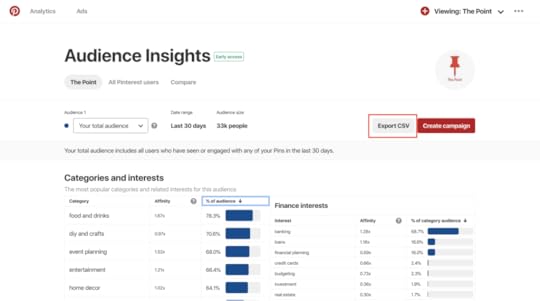  Image Courtesy of Pinterest
 Image Courtesy of PinterestOctober 2018
Pinterest introduced new filter performance data for Ads Manager in October. The new filters allow you to choose multiple criteria at once (as opposed to switching between screens) and to choose an objective, status, and conversion settings simultaneously. The data is also featured on a more dynamic graph, letting you select or search for specific campaigns, ad groups, and ads. Your choices are shown on the graph immediately.
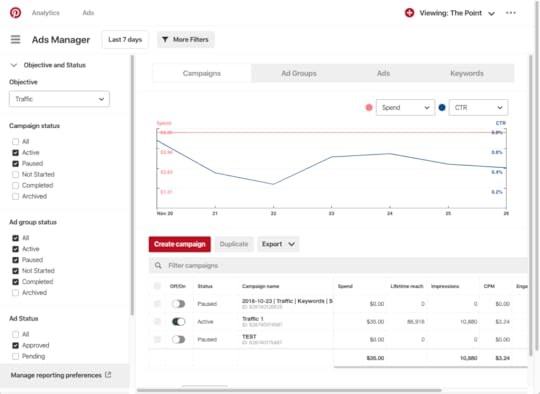  Image Courtesy of Pinterest
 Image Courtesy of PinterestNovember 2018
The biggest Ads Manager updates came in November. They included a customizable reporting view and access to engaged audience insights.
The customizable reporting view allows you to easily change your reporting view without leaving the page. It also has a drag-and-drop capability to help you reorder your data. You can save and return to your custom reporting view, so you never lose track of your metrics.
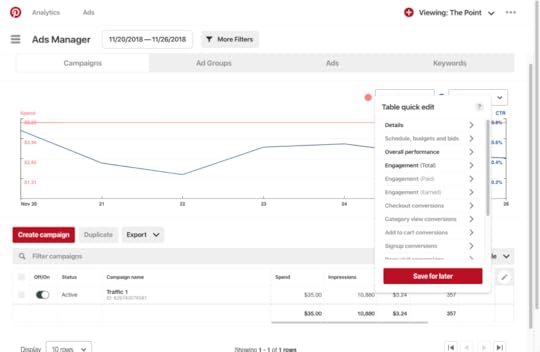  Image Courtesy of Pinterest
 Image Courtesy of PinterestThe new audience insights view provides more in-depth information about the users who are engaging with your Pins. You have access to information about your audience’s demographics and interests. To view these insights, log in to your Pinterest business account, navigate to the Audience insights page in Pinterest Analytics, and select “Your engaged audience” from the “Audience 1” dropdown.
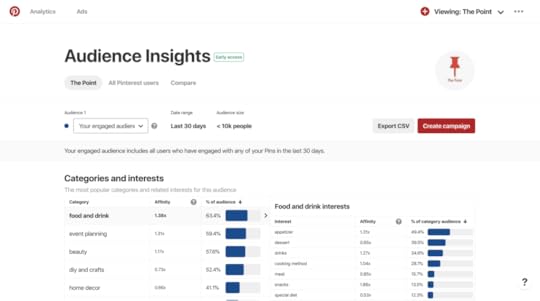  Image Courtesy of Pinterest
 Image Courtesy of PinterestJanuary 2019
We’re still early into the new year and already Pinterest has introduced many updates to Ads Manager. For example, the bulk editor is now easier to use, with new features like customizable views, saved templates, a glossary of terms and definitions, and easier formats. You can also now copy campaigns and ad groups into new campaigns with a different objective, as well as customize start and end times for ad groups.
Additionally, Pinterest introduced pre-populated details and campaign and ad group search. With pre-populated details, Pinterest automatically generates campaign and ad group information based on your existing behaviors to save you time. The campaign and ad group search lets you easily locate existing campaigns or ad groups without scrolling through a long list.
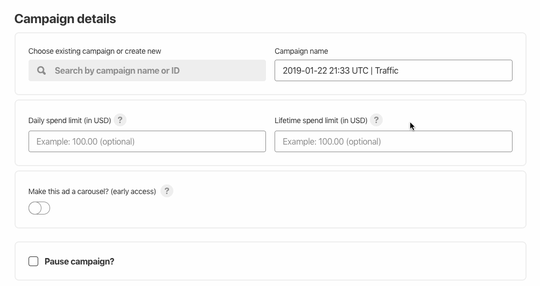  Image Courtesy of Pinterest
 Image Courtesy of PinterestAlthough its list of 2018 advertising updates isn’t as long as Facebook’s, Pinterest made impactful changes to set you up for success in 2019. It’s time to Pin 2019 as your year!
Written by Anna Hubbel, writer at AdvertiseMint, Facebook advertising agency reviews
The post A Look Back at Pinterest’s Ads Manager Updates in 2018 appeared first on AdvertiseMint.
January 30, 2019
Win at Pinterest Advertising with These 3 Tips
 January 30, 2019
January 30, 2019Anna Hubbel, writer at AdvertiseMint, Facebook ads agency

Pinning is winning. Yes, I am talking about Pinterest. Pinterest is a powerful platform that allows you to subtly reach your audience as they Pin things they find useful, interesting, or entertaining. When used right, Pinterest advertising can be very beneficial for your business, driving traffic to your business’s website and increasing online engagement. As with any form of advertising, however, there are tricks to the trade. This article will tell you how to run a successful Pinterest campaign.
Choose the Right Landing Page
You can have a whole lot of beautiful and engaging Pins but still fall short of your campaign’s goals if those Pins don’t take your audience to the right landing page. A landing page takes your audience to a website page when they click your Pin.
According to Pinterest, “Landing pages are a vital, often-overlooked piece of a successful Pinterest marketing strategy.” The landing page should feel like “a natural second step,” says Pinterest, which means it should make sense to the user where the Pin they clicked takes them. For example, if a Pin features a specific product, when a user clicks it, they should be directed to that product’s page on your website. It should not take them to a different product’s page or your website’s homepage.
Pinterest offers two simple tips for choosing the right landing page for your Pins.
Keep it simple. All landing pages should be relevant to what’s featured in the Pin. There should be no extra steps involved in finding it after that first click.
Set accurate expectations with clear text overlays. The text overlay in your Pin should transparently and succinctly tell your audience what they can expect when they click the Pin. For example, if you’re trying to acquire subscriptions for your online publication, the text should let your audience know they can sign up by clicking your Pin.
Use the Pinterest Tag
The Pinterest Tag functions similarly to the Facebook pixel: it tracks your audience’s interactions with your website after they’ve clicked on your Pinterest ad. It helps you measure your ad campaign’s performance or refine your audience targeting strategy.
To maximize the benefits of the Pinterest Tag, you can add Enhanced Match, an additional hashed email parameter that matches conversion data with the responsible Pinterest user. This option is particularly helpful when there isn’t a cookie. According to Pinterest, advertisers who have used Enhanced Match reported a nine percent average increase in conversion matches.
If you’re not sure whether or not you installed the Pinterest Tag correctly, use the Pinterest Tag Helper, a Google Chrome extension that ensures both the Tag and Enhanced Match are collecting the right data for Pinterest.
Choose the Right Ad Format
There are a variety of Pinterest ad formats to choose from. But which is the best for your campaign’s goals? Here’s what Pinterest recommends:
Standard Pins: These look and feel like regular Pins, but they’re promoted to reach more people. Use this format to increase brand awareness, boost traffic, or grow online and offline sales.
Promoted Video: Videos catch users’ attention as they scroll through their Pinterest feed. You have the options of vertical (standard) or maximum width (extends across both columns in feeds) video formats. Promoted video is best for increasing brand awareness.
Promoted Carousels: Show up to five images in a single Pin. You can include a different image, title, description, and landing page for each image. This format is best for increasing brand awareness or boosting traffic.
Promoted App Pins: This format features an install button that lets users discover and download your app directly through Pinterest. Use this format if you want to drive app installs.
Are you ready to win on Pinterest?
Written by Anna Hubbel, writer at AdvertiseMint, best Facebook advertising agency
The post Win at Pinterest Advertising with These 3 Tips appeared first on AdvertiseMint.
Facebook Fourth Quarter 2018 Earnings Report: What Lies Ahead
 January 30, 2019
January 30, 2019Anne Felicitas writer at AdvertiseMint, Facebook advertising agency
 Photo courtesy of Bloomberg. Photo by David Paul Morris.
Photo courtesy of Bloomberg. Photo by David Paul Morris.Today, CEO Mark Zuckerberg, COO Sheryl Sandberg, and CFO David Wehner spoke at Facebook’s fourth quarter 2018 earnings call, discussing accomplishments, challenges, and goals for 2019. Here are the highlights.
Users and Revenue
Daily active users (DAUs) – DAUs were 1.52 billion on average for December 2018, an increase of nine percent year-over-year.
Monthly active users (MAUs) – MAUs were 2.32 billion as of December 31, 2018, an increase of nine percent year-over-year.
Mobile advertising revenue – Mobile advertising revenue represented approximately 93 percent of advertising revenue for the fourth quarter of 2018, up from approximately 89 percent of advertising revenue in the fourth quarter of 2017.
Revenue– Revenue is $13.7 billion.
Community
While pushing to improve community features like Marketplace and fundraisers, Facebook will work on rolling out dating features across the world.
Video
Because video is growing rapidly, Zuckerberg believes it is a critical part of Facebook’s future. Users are spending more time on the platform, primarily because of video. But as Facebook moves video away from the feed, creating new tabs like Watch and IGTV, a business challenge arises.
“Video monetizes significantly less well per minute than people interacting in feeds,” said Zuckerberg. “As video grows, it will still displace some other services where we’d probably make more money.”
Meaning, as users spend more time away from feeds to watch videos on Watch or IGTV, they are spending less time away from an area where most ads live.
Messaging
Facebook plans to make WhatsApp and Messenger faster and simpler by rolling out payments and by creating tools that will help users easily connect with businesses. Additionally, Facebook will increase privacy and security by making messages ephemeral and by encrypting people’s conversations.
Stories
Facebook is still focused on making the platform more Stories-focused. Despite slow growth, Zuckerberg is optimistic that Facebook Stories will grow in popularity over time.
Election Interference
Facebook is currently partnered with governments and outside experts to prevent foreign interference.
By Anne Felicitas , editor at AdvertiseMint, best Facebook advertising agency
The post Facebook Fourth Quarter 2018 Earnings Report: What Lies Ahead appeared first on AdvertiseMint.
Facebook Third Quarter 2018 Earnings Report: What Lies Ahead
 January 30, 2019
January 30, 2019Anne Felicitas writer at AdvertiseMint, Facebook advertising agency
 Photo courtesy of Bloomberg. Photo by David Paul Morris.
Photo courtesy of Bloomberg. Photo by David Paul Morris.Today, CEO Mark Zuckerberg, COO Sheryl Sandberg, and CFO David Wehner spoke at Facebook’s third quarter 2018 earnings call, discussing accomplishments, challenges, and goals for 2019. Here are the highlights.
Users and Revenue
Daily active users (DAUs) – DAUs were 1.52 billion on average for December 2018, an increase of nine percent year-over-year.
Monthly active users (MAUs) – MAUs were 2.32 billion as of December 31, 2018, an increase of nine percent year-over-year.
Mobile advertising revenue – Mobile advertising revenue represented approximately 93 percent of advertising revenue for the fourth quarter of 2018, up from approximately 89 percent of advertising revenue in the fourth quarter of 2017.
Revenue– Revenue is $13.7 billion.
Community
While pushing to improve community features like Marketplace and fundraisers, Facebook will work on rolling out dating features across the world.
Video
Because video is growing rapidly, Zuckerberg believes it is a critical part of Facebook’s future. Users are spending more time on the platform, primarily because of video. But as Facebook moves video away from the feed, creating new tabs like Watch and IGTV, a business challenge arises.
“Video monetizes significantly less well per minute than people interacting in feeds,” said Zuckerberg. “As video grows, it will still displace some other services where we’d probably make more money.”
Meaning, as users spend more time away from feeds to watch videos on Watch or IGTV, they are spending less time away from an area where most ads live.
Messaging
Facebook plans to make WhatsApp and Messenger faster and simpler by rolling out payments and by creating tools that will help users easily connect with businesses. Additionally, Facebook will increase privacy and security by making messages ephemeral and by encrypting people’s conversations.
Stories
Facebook is still focused on making the platform more Stories-focused. Despite slow growth, Zuckerberg is optimistic that Facebook Stories will grow in popularity over time.
Election Interference
Facebook is currently partnered with governments and outside experts to prevent foreign interference.
By Anne Felicitas , editor at AdvertiseMint, best Facebook advertising agency
The post Facebook Third Quarter 2018 Earnings Report: What Lies Ahead appeared first on AdvertiseMint.
Avoid These 4 Instagram Username Mistakes
 January 30, 2019
January 30, 2019Anne Felicitas writer at AdvertiseMint, Facebook ads agency
  chuttersnap / Unsplash
 chuttersnap / UnsplashLet’s be candid. When you created your Instagram account eight years ago, and the sign-up form prompted you to choose a username, you rushed the process and used the first three names that came to mind.
Your Instagram username is more than a string of words you put together for the sake of creating an account. It is your identity on the platform, the key to determining whether or not users will find you. Choose the right username, and you will increase discoverability and leave a lasting impression on users. Choose incorrectly, and you will be lost and forgotten.
If you want to create an Instagram username that will withstand the test of Search and competing users, avoid these pitfalls.
1. Using a String of Recurring Letters
It’s difficult to create a unique username on a platform that has two billion monthly users. When you created your account, you likely tried several usernames before finding one that wasn’t already taken. To create a username that hasn’t been claimed, you’ll likely add a recurring string of letters. If jimmyboi is already taken, you will simply add another “i” to differ from the already claimed name.
Usernames with recurring letters are difficult to find on Search. If you searched for jimmyboi on Instagram and missed one letter, that user will not appear on your results. To remember the username’s exact spelling, you would need to count and memorize the number of recurring letters—that may be too difficult for your brain, especially if the sequence contains more than seven items.
Of course, certain words and names naturally have recurring letters. The “little” in the username littlebananie contains two letter ts. Although the ts are recurring, they are easy to remember because the original spelling includes two ts. Adding another t to differentiate the username will confuse users because “little” doesn’t contain three ts.
If you want to differentiate your username from an already existing one, instead of multiplying the letters, add a symbol, a word, or a number: jimmyboi_me, littlejimmyboi, or 1jimmyboi.
2. Changing Your Username Frequently

Frequently changing your username will make it difficult for people to find you. Your username should be permanent, and you should only change it if you’re rebranding. Don’t change your username on a whim, and don’t treat it like a profile picture that you swap every few weeks.
Avoid changing your username and carefully think about the name you want people to associate with you. Brainstorm a few ideas, ask for people’s opinion, and choose the one you absolutely love. If you think the username you created won’t stand the test of time or your taste, don’t use it. Keep brainstorming until you find the one.
3. Using Phrases with Contractions
Avoid usernames that include contractions, shortened versions of words that contain an apostrophe to replace omitted letters. For example, “aren’t” for “are not,” “shouldn’t” for “should not,” and “I’m” for “I am.”
Although Instagram allows certain symbols in usernames, it doesn’t allow you to use certain punctuations, including the apostrophe in contractions. So instead of having it’snotyouit’sme as your username, you will be forced to write it as itsnotyouitsme.
Without the apostrophe in the contraction, readers will likely struggle to read and understand your username. For example, users could read the username immadeinheaven as “imma die n heaven” when it should be read as “I’m made in heaven.”
If you insist on using phrases with contractions, separate each word with a symbol for clarity: immadeinheaven then turns to im.made.in.heaven. Better yet, avoid usernames with contracted words altogether.
4. Using Long Phrases

Some people, instead of using a nickname or a full name, will use long phrases as their usernames, like simplyridiculousfangirl or atravelingnomadofargentina. Long phrases as usernames are not only hard to remember, but they are also difficult to read when seen for the first time. Just look at this username: atravelingnomadofargentina. How long did it take you to read and understand it? Not only is the length cumbersome to the eye, but the reader must separate each word to make sense of it.
Shorten your long username. Use only the important words from the phrase. For example, you can pare the username simplyridiculousfangirl down to ridiculousfan. You can also replace a long word with a shorter synonym with the help of a thesaurus. For example, change ridiculousfangirl to goofyfangirl, swapping “ridiculous” for the synonym “goofy.”
If you insist on using a long phrase, break up words with symbols, like a dash, an underscore, or a period to improve readability: simply_ridiculous_fan_girl, simply.ridiculous.fan.girl., simply-ridiculous-fan-girl.
You may think nothing of your Instagram username, but your username is more than a name. It is your identity. It can make or break your discoverability on Instagram’s Search.
I gave you four pitfalls to avoid when creating your Instagram username. If there’s one thing you should remember after reading my advice, it’s this: keep it simple. Oftentimes, simple is better.
By Anne Felicitas , editor at AdvertiseMint, Facebook advertising agency reviews
The post appeared first on AdvertiseMint.
January 29, 2019
WhatsApp Business Is Rolling Out to Desktop Devices
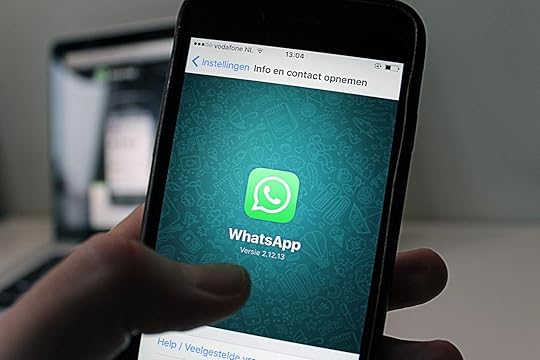 January 29, 2019
January 29, 2019Anne Felicitas writer at AdvertiseMint, Facebook ads company
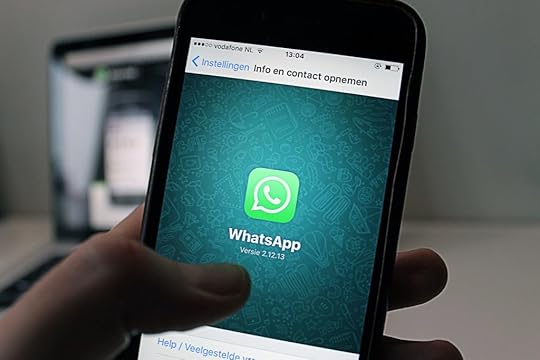
It’s difficult to work from your phone. Dealing with a smaller screen and an even smaller keyboard, efficiently getting tasks done from a small square is significantly more difficult than from a desktop or laptop. Just imagine writing an article or a long report from your iPhone—what a nightmare.
To accommodate businesses, WhatsApp is making the WhatsApp Business features available to desktop devices and the web, as reported by Tech Crunch.
Quick Replies is one of the tools that WhatsApp is rolling out to desktop devices. The feature allows businesses to respond to common questions from customers using pre-written replies. Saved replies and automated greetings are also features that people can soon access from their computers.
By Anne Felicitas , editor at AdvertiseMint, best Facebook advertising agency
The post WhatsApp Business Is Rolling Out to Desktop Devices appeared first on AdvertiseMint.
How to Verify Your Pinterest Account
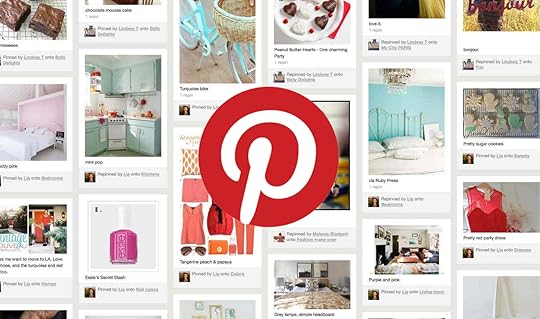 January 29, 2019
January 29, 2019Anna Hubbel, writer at AdvertiseMint, Facebook ads company

We’re used to seeing the blue verification badges next to celebrity and brand names on Facebook and Instagram. But did you know you can also get verified on Pinterest?
Getting verified on Pinterest serves the same purpose as getting verified on Facebook or Instagram. It tells audiences that you’re an authentic business, brand, or celebrity, as opposed to an impersonator or fan account. On Pinterest, verification is especially important for branding.
To get verification, you must first claim your website, which displays your full website URL on your profile. Pinterest also recommends uploading your logo to your profile. Once you’ve taken all the steps to prove you’re the real deal, Pinterest will give you a nice red check mark, so you can showcase your stamp of authenticity with pride. This article will tell you everything you need to know about getting verified on Pinterest.
Who Can Get Verified?
Pinterest accounts with notable names, like celebrities, brands, or media, can receive verification. To qualify, you must have a business account.
Pinterest’s Help Center explains the purpose of verification this way: “The goal of this checkmark is to help people to find the accounts they’re looking for. (For example, you should be able to easily distinguish Abraham Lincoln’s Pinterest account from the Pinterest account for an Abraham Lincoln fan site.)”
How Long Does the Verification Process Take?
Claiming your website on Pinterest can take as little as a few minutes or as long as a few hours, depending on how tech-savvy you are. The review process, however, normally takes 24 hours. You will receive an email from Pinterest about your website’s verification, so keep an eye on your inbox. You can also check the Claim Website section of your Pinterest account to see if there’s an approval check mark next to it.
Getting the official, red Pinterest check mark may happen as soon as Pinterest approves your website verification, or it may take a few days. It depends on whether Pinterest identifies areas of your account that bring your authenticity into question. So be as thorough and honest with your profile as you can. For example, connect your Pinterest account to your brand’s other social media accounts, upload your logo, etc.
Pinterest will likely email you if your website claim is denied. If that happens, or if you’ve claimed your website but Pinterest still hasn’t given you its verification stamp, contact Pinterest to find out what you need to do.
How to Verify Your Pinterest Website
Step 1: Upgrade to a business account. Select the three-dot menu at the top right corner of your screen and select “Upgrade Now.” (It’s free.)

Step 2: Follow the prompts for setting up your business account.

Step 3: Once you’ve completed the business account setup, select the three-dot menu again and choose “Settings.”

Step 4: From the menu on the left, select “Claim” and enter your website URL.

Step 5: You will be prompted to choose a claim option. For this example, claim your website.

Step 6: Add the HTML tag Pinterest gives you to your website’s backend script area by copying and pasting it. This process will vary, depending on what site you used to build your website.

Step 7: Go back to your Pinterest page and click “Next” in the pop-up. Another pop-up will appear, prompting you to “Submit” your request for review.

What Are the Benefits?
According to Tehmina Zaman in an article about Pinterest verification, when you’ve verified your website, you will
Get more engagement with your Pinterest content because users will see that you’re authentic.
Drive traffic to your website because your Pinterest followers can easily navigate to your website.
Boost your online visibility and SEO because you will be considered more of a prominent name for your type of content by search engines.
Have better branding for your social media identity.
Verification is important in maintaining a successful image for your brand on social media. In addition to getting verified on Pinterest, you should also verify your identity on Instagram and Facebook.
Written by Anna Hubbel, writer at AdvertiseMint, Facebook advertising agency reviews
The post How to Verify Your Pinterest Account appeared first on AdvertiseMint.



